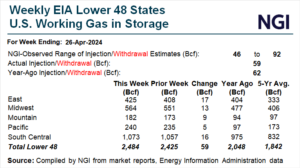Markets | Natural Gas Prices | NGI All News Access | Shale Daily
Natural Gas Futures Only Slightly Higher After Storage Data-Led Rally Loses Steam
Natural gas traders appeared to need more convincing that the hugely bullish miss in the latest government inventory data holds water. After bouncing as much as 14.0 cents off its intraday low, the September Nymex gas futures contract settled Thursday at $2.519, up only 2.2 cents from Wednesday’s close. October futures picked up 4.4 cents to reach $2.636.

At A Glance:
- Production falls to 97 Bcf/d
- Forecasts for mixed demand
- NGI models draw of 41 Bcf
Spot gas prices were mixed, with western U.S. locations rebounding from a multi-day sell-off. NGI’s Spot Gas National Avg. slipped 3.5 cents to $2.230.
With only minor fluctuations in the weather data, price action early Thursday was solely driven by the Energy Information Administration’s (EIA) weekly storage report, which was well outside the range of expectations ahead of the report.
The EIA said stocks for the week ending Aug. 18 rose by a net 18 Bcf, below a wide range of injection estimates from 27-50 Bcf. The average of a Wall Street Journal poll averaged a build of 33 Bcf, while the median of a Reuters survey landed at 31 Bcf. NGI was on the right side of the projections, but its modeled 29 Bcf also came in well above the EIA print.
“Texas,” said independent weather forecaster Corey Lefkof on energy chat Enelyst.
Lefkof and other Enelyst participants were quick to put the blame on the Lone Star State for the bullish miss in the latest EIA storage report. The South Central region recorded a net 21 Bcf decline in stocks, with 12 Bcf withdrawn from salt inventories and another 8 Bcf from nonsalt facilities.
There were “epic burns with that draw in the South Central,” Lefkof said.
That said, power burns alone were not seen as the sole culprit to the steep withdrawal. After all, Texas has experienced record heat since mid-June, and natural gas demand for power generation has been lofty since. Instead, it is the combination of the strong power burns and low wind generation that likely resulted in the increased pull on natural gas, according to some market observers.
Other Enelyst participants said they expect to see a revision in the data soon. There is “something off with this number,” Enelyst managing director Het Shah said. “Hard to be off so specifically in one region/one category.”
Elsewhere across the country, Midwest stocks increased by 19 Bcf and East stocks by 14 Bcf, according to EIA. The Mountain region added 4 Bcf, while the Pacific added 2 Bcf.
Total working gas in storage climbed to 3,083 Bcf, which is 513 Bcf higher than year-earlier levels and 268 Bcf higher than the five-year average, EIA said.
East Daley Analytics analyst Jack Weixel noted that the surplus to the five-year average is now at the lowest levels since the week ending Feb. 17.
The market’s miss of the mark regarding supply/demand balances forced bears to cover, according to NatGasWeather. After all, the next EIA report “now has the potential to again be decently lower than the five-year average – if Thursday’s report is true.”
The firm noted that the paltry build also provides a reason for the September contract to make another run for $2.70 ahead of Tuesday’s expiration.
“As we’ve been mentioning, $2.70 is the level prices keep returning to the past two-plus months anytime prices start to work decently away from it, just like prices did” Thursday morning, NatGasWeather said.
Analysts trying to assess where next week’s EIA injection may fall indicated the latest data threw them a curveball. An early survey by The Desk showed estimates for the week ending Aug. 25 ranging from 24-34 Bcf, which would compare with the year-earlier injection of 61 Bcf and the 51 Bcf five-year average.
“If you’re looking for a net 61 Bcf over the past two weeks, then next week needs to be 43 Bcf,” Weixel said.
Without additional support from other factors, bears may continue to have the upper hand in the near term.
Houston-based trader and Vortex Commodities CEO Brian Lovern said the warm waters of the Atlantic – and more important, the Gulf of Mexico (GOM) – lend themselves to increased storm activity in the next month or so. “Harold was a bust for rain” in the densely populated Houston area, but the market is keenly aware of the potential for more storm activity ahead.
“Tropical Storm Franklin is actually expected to stay out at sea, but we are watching a system crossing Central America that could get in the eastern Gulf of Mexico over the weekend into early next week,” Lovern told NGI. “Doesn’t appear a threat to any LNG though, as even if something forms, its likely target is Florida.”
In 2020, Hurricane Laura shut down Cameron’s liquefied natural gas export facility in Louisiana for more than a month.
Lovern said it’s possible there may be a lull in activity again after this flurry is done, especially with El Niño “coming on strong, but of course, you never know. After September, it’s tough to get a strong enough system enough west in the Gulf that would really disrupt LNG. My hunch is we will be okay this season…It only takes one storm to leave a mark, even if it is an overall quiet season.”
Weakening Cash
Spot gas prices at most U.S. locations softened on Thursday, with the intense heat that has blanketed the country set to ease in the next couple of days.
NatGasWeather said demand on the national level should remain elevated through Saturday as record heat continues over the interior United States. Highs in the 90s and 100s remained in the forecast, with power burns likely to hold around 50 Bcf.
The hot ridge is seen shifting over the U.S West/Central next week, according to the forecaster. This should open the door for weather systems with showers and cooling to sweep across the Great Lakes and East. The storms could usher in far more pleasant daytime temperatures in the 60s to 80s, resulting in near-normal national demand.
“Much of the weather data suggests a hot pattern will return over most of the U.S. Sept. 2-7 as upper high pressure over the central and southern U.S. expands to include the East, with highs of mid-80s and 90s,” NatGasWeather said. “Although, that’s quite far out and where changes are expected due to numerous tropical systems over the Northern Hemisphere that are likely to give the weather models fits.”
As for pricing, Henry Hub next-day gas fell 16.5 cents day/day to average $2.425. Florida Gas Zone 3 tumbled a steeper 28.5 cents to $3.185.
In Texas, where the electric grid operator on Thursday issued a public call for conservation from 3-10 p.m. CT, prices were mixed. In the South, NGPL S. TX cash was down 13.5 cents to $2.220. Prices also were lower in the eastern part of the state, while in West Texas, Waha edged up 3.0 cents to $1.995.Additional losses were seen in the country’s midsection. Chicago Citygate cash was down 12.0 cents to $2.220, Southern Star was down 17.0 cents to $2.180.
© 2024 Natural Gas Intelligence. All rights reserved.
ISSN © 1532-1231 | ISSN © 2577-9877 | ISSN © 2158-8023 |


